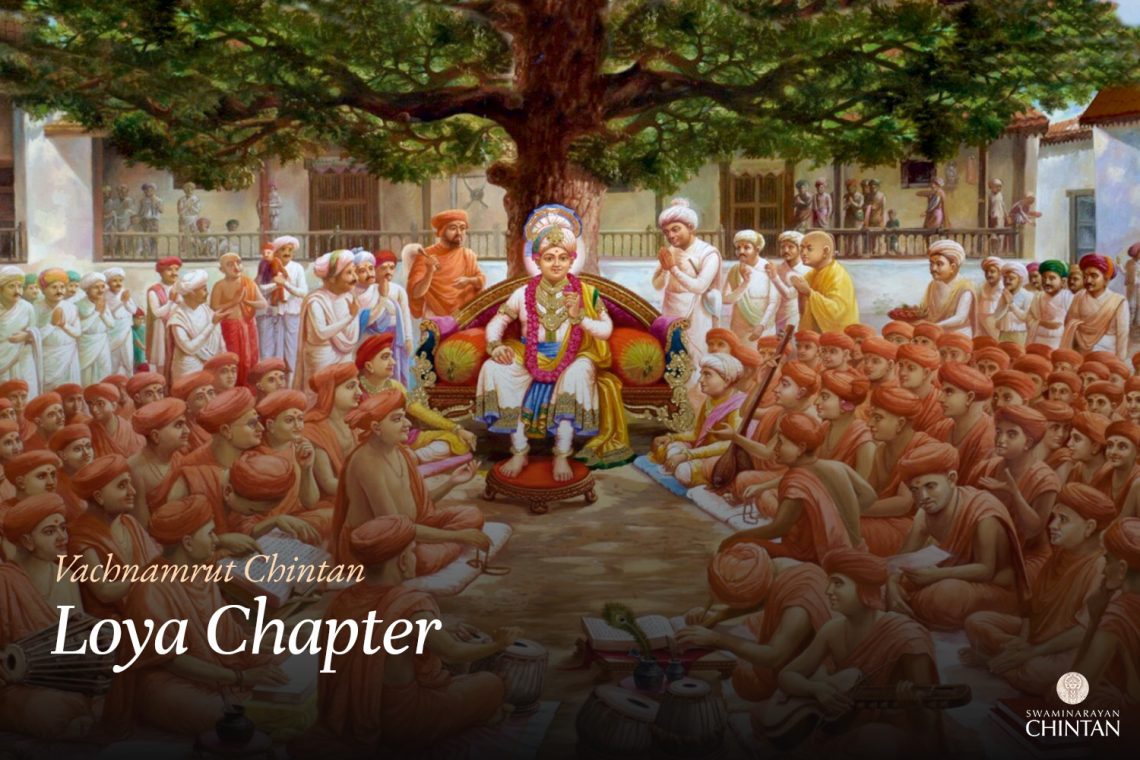Asserted Topics:
- The understanding of shastra (holy scriptures) by vicious and saintly people.
Main Points:
- Vicious people view everything as equal (Brahm – the supreme consciousness), whereas saintly people see distinctions in everything, especially between Bhagwan (God) and other entities.
- For vicious people, the primary focus is on bhavna (contemplation or sentiment), while saintly people consider discernment of objects as equally important before engaging in contemplation.
- The weak intent of the vicious person and the pure intent of the saintly person influence their respective beliefs.
Commentary:
This Vachanamrut discusses the understanding of vicious and saintly people. In this Vachanamrut, Shukmuni asks Maharaj how a vicious person and a saintly person grasp the teachings of the shastras.
Maharaj replies by first pointing out that their opinions on meditation differ greatly. Saintly people believe that meditation should be on one Paramatma (the supreme soul) or His avatars (incarnations) and images. In contrast, vicious people think that one can meditate on any form that pleases their mind. They believe that one should meditate on whatever object their mind is attracted to, and if that object happens to be a male or female form, they should regard it with a Brahm-focused perspective. Saintly people, however, assert that one should meditate only on objects and individuals connected to Bhagwan, such as His dhams (divine abodes) and His muktas (liberated souls).
From the viewpoint of vicious people, every form in the universe is worthy of meditation because all forms are Brahm. They believe that one should have Brahm-focused contemplation towards all forms. However, contemplating Brahm in this way does not turn the object into Brahm. To engage in higher contemplation, the discernment instructed by the shastras is necessary. Meditating on any random object without this discernment does not yield any benefit.
Even if one contemplates highly on objects like women or wealth, where the human mind is perpetually entangled due to sensory enjoyment, such contemplation will not remove the mind’s disturbances. When a disturbed mind begins meditating on these objects, its disturbances will only increase. There is a limit to where and how contemplation should be directed, and discernment is essential to ensure that contemplation is fruitful. The natural attraction between male and female is deeply rooted in the human psyche since time immemorial, and suppressed disturbances can resurface when such objects are meditated upon. In such cases, the shastras advise fostering detachment through recognizing the faults in these forms and avoiding mental engagement with them. Replacing this advice with Brahm-focused contemplation towards such forms is a result of the weak intent harbored by the vicious person.
The decision of where to place one’s faith or bhavna (contemplation) and on whom to focus one’s meditation clearly distinguishes between a saintly person and a vicious person. The major difference in the understanding of saintly and vicious people lies in the fact that both engage in lofty bhavna, but the reality of the object they focus on is also crucial. Mere empty bhavna is not fruitful. When the object of contemplation is real and highly sublime, it yields sublime results. Shreeji Maharaj has said in the Vachanamrut that although the Gopis were attached to Shree Krishna Bhagwan with feelings of desire, they still transcended the cycle of birth and death because their object of focus was the supreme and truthful Paramatma. On the other hand, if worldly women serve their husbands with even the highest level of bhavna, they cannot achieve the same status as the Gopis. It is not possible. Maharaj states that instead, they attain the most terrible hell because the greatness of the object of focus is equally necessary.
A saintly person chooses Paramatma for meditation. They focus on Paramatma, His avatars, or His images as the object of their meditation, and then they engage in high bhavna toward them. As a result, this bhavna bears real fruits, and their soul attains salvation.
Vicious people, however, choose their own favorite opposite-sex individuals—men or women—as the object of their meditation and engage in lofty bhavna toward them. However, since these objects are filled with the material world’s flaws and distortions of Maya, their bhavna yields no results. Instead, it leads to the most dreadful hell. Such actions stem from the inherent weakness of their mind.
In the Vachanamrut, another indication given through the understanding of a saintly person is that mere realization does not lead to salvation. After attaining the direct experience of Paramatma or His great saints, it is essential to develop high bhavna to achieve one’s benefit. Throughout the history of the shastras, those who have cultivated high bhavna after realizing the truth have certainly transcended Maya. However, those who failed to recognize the opportunity and did not develop bhavna after attaining realization did not succeed. For example, even after the Yadavas attained Shree Krishna Bhagwan, they could not cultivate the appropriate bhavna towards Bhagwan. Although the reality was present, in the absence of bhavna, their efforts did not bear fruit, and as a result, they are not considered true devotees, as described in the Bhagwat. In contrast, the Gopis, despite being driven by desire, were considered equal to the Shruti (Vedic revelations). Thus, as Maharaj mentions in the Vachanamrut, high bhavna towards a pure entity is essential for attaining salvation.
It is not appropriate to question what makes bhavna so significant. On the contrary, unless one cultivates an understanding of detachment or renunciation towards non-saintly objects (asatpadarth), they will continue to pose obstacles on the path of a seeker until the seeker cultivates such understanding. One must cultivate an attitude of renunciation or indifference according to the appropriateness of the situation. Only then can the bondage of non-saintly objects be removed. Maharaj states that in the understanding of a saintly person, the form of Bhagwan and other forms are not the same; there is a significant difference between the two. Vicious people, however, attempt to equate everything by any means. They question why the shastra created distinctions when, in their view, there is no real difference. They claim that meditating on a woman or meditating on the image of Paramatma is the same since both are Brahm. This is extreme indiscretion. In the understanding of a saintly person, as Maharaj says, even the contemplation of Bhagwan’s forms with four arms or eight arms serves to distinguish Bhagwan from others. In their view, even Bhagwan’s devotees and ordinary beings are not the same; they are distinct. Believing everything to be equal is the understanding of a vicious person, and such a belief stems from a weak intent working behind the scenes.
Maharaj says that one should meditate only on the form of Bhagwan that has been bestowed upon them and not on the images of His previous avatars. Why is this so? Because if one abandons the attitude of fidelity (pativrata) towards the form they have received and begins to meditate on those other forms, they will eventually start focusing on other deities or humans as well, and everything will become equal. They will lose their fidelity. For this reason, the understanding of a vicious person equates everything to Brahm. Under the guise of equality and oneness, they seek only to fulfill their weak desires, with no other intent.
Glossary
| Paramatma – Supreme God God, the all-pervading and ultimate reality. |
| Brahm – Supreme Reality, God The ultimate truth in Vedanta, often misinterpreted by dry Vedantists. |
| Bhavna – Contemplation or sentiment The mental attitude or emotion directed towards a specific object or being. |
| Shastra – Holy Vedic Scriptures Texts that provide spiritual and philosophical guidance for God- realization & Liberation |
| Shastra – Holy Vedic Scriptures Texts that provide spiritual and philosophical guidance for God- realization & Liberation |
| Dveshbuddhi – Intense dislike A strong aversion to certain traits or behaviors, often leading to discrimination between what is acceptable and unacceptable. |
| Grahya – Acceptable That which should be embraced or adopted. |
| Agrahya – Unacceptable That which should be avoided or rejected. |
| Indriya – Senses The five senses (sight, sound, smell, taste, and touch) that engage with external objects. |
| Man – Mind The inner faculty that processes sensory input and generates thoughts and emotions. |
| Antahkaran – Inner faculties The mind, intellect, consciousness, and ego, which help in acquiring spiritual knowledge. |
| Jeev – Soul The individual living entity, distinct from the body and mind, that experiences life and karma. |
| Vishay – Objects of sensory pleasure Anything that engages the senses, leading to attraction or attachment. |
| Bhogbuddhi – Inclination to indulge The mental state that seeks pleasure from sensory objects. |
| Vairagya – Detachment From Everything Except God |
| Nishchay – Firm Faith in Manifested God Believing Manifested God (Bhagwan Swaminarayan) as “My Beloved God” (My Istadev) |
| Maya – Illusion The material energy that entangles the Jeev in worldly existence and distracts from Bhagwan. |
| Avatars – Incarnations of God Divine manifestations of Bhagwan in different forms to fulfill specific purposes. |
| Mukta – Liberated soul A soul that has transcended Maya and attained eternal service of Bhagwan. |
| Gopis – Devotees of Krishna The cowherd women of Vrindavan known for their unparalleled love for Krishna. |
| Shruti – Vedic texts The revealed scriptures that convey eternal knowledge, including the Vedas and Upanishads. |
| Dharma – Righteousness The moral and ethical principles that sustain order in life. |
| Sant – Saint One who has renounced family and married life, accepted Bhagwati Diksha, and is guiding others toward Bhagwan and moksh. |
| Kal – Time The influence of the time period or era on a person’s tendencies and inclinations. |
| Sang – Association The company or social influence that shapes a person’s habits and mindset. |
| Pativrata Bhavna – Attitude of fidelity (Loyalty) The firm commitment, Loyalty and devotion to one’s chosen deity or spiritual master. |
| Gyan – Knowledge |
| Asatpadarth – Non-saintly objects Material or worldly entities that divert one from the path of spirituality. |
| Yadavas – Descendants of the Yadu dynasty The clan associated with Lord Krishna, many of whom failed to recognize His divinity fully. |

